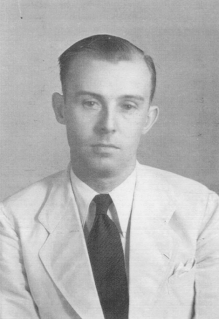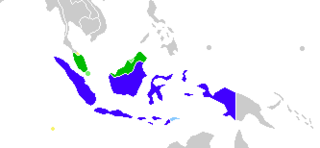
A creole language, or simply creole, is a stable natural language that develops from the simplifying and mixing of different languages at a fairly sudden point in time: often, a pidgin transitioned into a full-fledged language. While the concept is similar to that of a mixed or hybrid language, a creole is often additionally defined as being highly simplified when compared to its parent languages. However, a creole is still complex enough that it has a consistent system of grammar, possesses a large stable vocabulary, and is acquired by children as their native language, all of which distinguishes a creole language from a pidgin.
Papia Kristang, or just Kristang, is a creole language. It is spoken by the Kristang, a community of people of mixed Portuguese and Asian ancestry, chiefly in Malacca (Malaysia).
Macanese Patois is a Portuguese-based creole language with a substrate from Malay, Cantonese and Sinhalese, which was originally spoken by the Macanese community of the Portuguese colony of Macau. It is now spoken by a few families in Macau and in the Macanese diaspora.
In addition to its classical and literary form, Malay had various regional dialects established before the rise of the Malaccan Sultanate. Also, Malay spread through interethnic contact and trade across the Malay archipelago as far as the Philippines. That contact resulted in a lingua franca that was called Bazaar Malay or low Malay and in Malay Melayu Pasar. It is generally believed that Bazaar Malay was a pidgin, influenced by contact among Malay, Chinese, Portuguese, and Dutch traders.
A mixed language is a language that arises among a bilingual group, typically very abruptly, combining aspects of two or more languages but not clearly deriving primarily from any single language. It differs from a creole or pidgin language in that, whereas creoles/pidgins arise from populations trying to imitate a language where they have no fluency, a mixed language arises in a population that is fluent in both of the source languages.
Malaysian and Indonesian are two standardised registers of the Malay language, used in Malaysia and Indonesia, respectively. Both varieties are generally mutually intelligible, yet there are noticeable differences in spelling, grammar, pronunciation and vocabulary, as well as the predominant source of loanwords. The differences can range from those mutually unintelligible with one another, to those having a closer familial resemblance. The regionalised and localised varieties of Malay can become a catalyst for intercultural conflict, especially in higher education.

The Mardijker were a community in amongst others Batavia, made up of descendants of freed slaves. They could be found at all major trading posts in the East Indies. They were mostly Christian, of various natives from conquered Portuguese territories, and some Portuguese ancestry. They spoke a Portuguese patois, which has influenced the modern Indonesian language. The Dutch also referred to them as inlandse Christenen.
Betawian, also known as Jakartan Betawi or Batavian, is the spoken language of the Betawi people in Jakarta, Indonesia. It is the native language of perhaps 5 million people; a precise number is difficult to determine due to the vague use of the name.
Javindo, also known by the pejorative name Krontjong, was a Dutch-based creole language spoken on Java, Indonesia. The name Javindo is a portmanteau of Java and Indo, the Dutch word for a person of mixed Indonesian and Dutch descent. This contact language developed from communication between Javanese-speaking mothers and Dutch-speaking fathers in Indo families. Its main speakers were Indo-Eurasian people. Its grammar was based on Javanese while the vocabulary was based on Dutch. Dutch lexicon was pronounced in a Javanese manner.
The modern Malay alphabet or Indonesian alphabet consists of the 26 letters of the ISO basic Latin alphabet without any diacritics. It is the more common of the two alphabets used today to write the Malay language, the other being Jawi. The Latin Malay alphabet is the official Malay script in Indonesia, Malaysia and Singapore, while it is co-official with Jawi in Brunei.
Sri Lankan Malay is an Austronesian language formed through a mixture of Sinhala and Shonam, with Malay being the major lexifier. During the 17th and 18th centuries, the Dutch who had occupied Batavia of Java exiled native rebels and royalty to Sri Lanka, and they made their first settlements in Hambantota and Kirinde. Later on, the Dutch also garrisoned their military, composed of Malays, in other parts of Sri Lanka. As a result, some scholars even believe that SLM is closely associated with the Batavian dialect of Malay. Sri Lankan Malay (SLM), is found in the Central (Kandy), Southern, and Western provinces of the country. The Malay population living in Kinniya and Mutur no longer speak Malay and have resorted to either Sri Lankan Tamil or Sri Lankan Moor Tamil (SLMT). [4]The majority of the speakers today reside in Northern Colombo. Sri Lankan Malays now constitute 0.3% of the Sri Lankan population, which is approximately 46,000 people.The exact number of speakers is unknown and there are no linguistic statistics available on the number of speakers living in or outside Sri Lanka. Based on the ethnic statistics of Sri Lankan Malays, the estimation of the number of Sri Lankan Malay speakers is between 30,000 to 40,000.
According to the theory of monogenesis in its most radical form, all pidgins and creole languages of the world can be ultimately traced back to one linguistic variety. This idea was first formulated by Hugo Schuchardt in the late 19th century and popularized in the late 1950s and early 1960s by Taylor (1961) and Thompson (1961). It assumes that some type of pidgin language, dubbed West African Pidgin Portuguese, based on Portuguese was spoken from the 15th to 18th centuries in the forts established by the Portuguese on the West African coast. This variety was the starting point of all the pidgin and creole languages. This would explain to some extent why Portuguese lexical items can be found in many creoles, but more importantly, it would account for the numerous grammatical similarities shared by such languages.
Indo people are a Eurasian people of mixed Indonesian and European descent. Through the 16th and 18th century known by the name Mestiço. To this day they form one of the largest Eurasian communities in the world. The early beginning of this community started with the arrival of Portuguese traders in South East Asia in the 16th century. The second large wave started with the arrival of the Dutch East India Company (VOC) employees in the 17th century and throughout the 18th century. Even though the VOC is often considered a state within a state, formal colonisation by the Dutch only commenced in the 19th century.

Robert Nieuwenhuys was a Dutch writer of Indo descent. The son of a 'Totok' Dutchman and an Indo-European mother, he and his younger brother Roelof, grew up in Batavia, where his father was the managing director of the renowned Hotel des Indes.

Indos are a Eurasian people of mixed Indonesian and European descent. The earliest evidence of Eurasian communities in the East Indies coincides with the arrival of Portuguese traders in the 16th century. Eurasian communities, often with distinct, specific names, also appeared following the arrival of Dutch (VOC) traders in the 17th and 18th century.

The Bataviaasch Nieuwsblad was one of the leading and largest daily newspapers in the Dutch East Indies. It was based in Batavia on Java, but read throughout the archipelago. It was founded by the famous Dutch newspaperman and author P. A. Daum in 1885 and existed to 1957.
Victor Ido is the main alias of the Indo (Eurasian) Dutch language writer and journalist Hans van de Wall. Born in Surabaya, Dutch East Indies from a Dutch father and Indo (Eurasian) mother. Ido was the Art Editor of P.A.Daum's Bataviaasch Nieuwsblad and later the Chief Editor of newspaper Batavia's Handelsblad as well as an accomplished musician (organist).

Dutch Indies literature or Dutch East Indies literature is a section of Dutch literature encompassing Dutch language literature inspired by colonial and post-colonial Insulinde from the Dutch Golden Age to the present day. It includes Dutch, Indo-European and Indonesian authors. Its subject matter thematically revolves around the VOC and Dutch East Indies era, but also includes the postcolonial discourse.









